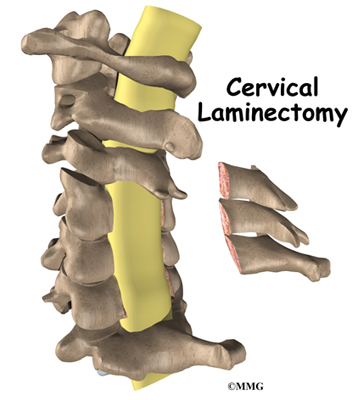Cervical Laminectomy
What is a Cervical Laminectomy?
The cervical spine is the spine in the neck. Each vertebra (bone of the spine) includes a section called the lamina that covers the spinal canal. A laminectomy is the removal of that section. A cervical laminectomy, therefore, is the removal of the bone that covers the spinal canal from a bone in the neck.
When is this Cervical laminectomy Procedure Performed?
A cervical laminectomy is performed for certain patients with cervical spinal stenosis, which is a narrowing of the spinal canal. Stenosis may be caused by a number of degenerative spine conditions, including wear and tear on the bones, discs, and ligaments. A narrow spinal canal can compress (pinch) the spinal cord and surrounding nerves. Compression may irritate a spinal nerve or nerves, causing radiculopathy (pain, weakness, numbness or tingling in one limb). Compression of the spinal cord itself can damage its delicate tissues and cause myelopathy (pain, weakness, numbness or tingling in both arms or legs, difficulty walking, and/or loss of bowel or bladder control).

A laminectomy decompresses (removes the pressure from) the spinal cord and spinal nerves. It is generally effective when performed in patients who have an identifiable compression resulting in radiculopathy or myelopathy.
How is this Procedure Performed?
A cervical laminectomy is performed under general anesthesia.
An incision is made down the middle of the back of the neck to allow the surgeon to access the back of the cervical spine. The surgeon then removes the lamina. Removing the lamina relieves the pressure on the spinal cord. The “roof” of the spinal canal is left open; the lamina does not need to be replaced by a plate or bone graft.
After a laminectomy, the surgeon may perform a spinal fusion to ensure the spinal column is stable. During a spinal fusion, the surgeon inserts a bone graft to join two or more of the affected vertebrae together into a single unit. In some cases, the surgeon may use instruments such as a metal plate and screws to hold the bones in place until they heal.
Finally, working layer by layer, the surgeon will close the incision using absorbable sutures (sutures that can be dissolved by the body and do not need to be physically removed).
What Should I Expect After the Procedure?
Post-surgical pain is usually controlled with intravenous pain medication for the first day, followed by oral pain medication. On average, patients are discharged from the hospital two to three days following surgery. Most patients are encouraged to walk as soon as possible, often on the day of surgery.
At home, patients are usually encouraged to increase their activities as they are able to tolerate. A soft collar may be prescribed for comfort in patients in whom a fusion has not been performed. In patients with fusion, however, a firm cervical collar may be prescribed for up to 6 weeks following the surgery.
The surgeon will schedule a follow up visit, typically 4-6 weeks after surgery. Physical therapy that focuses on the neck will often be started at the time of the follow up visit. Physical therapy initially involves stretching and range of motion exercises, and then endurance and strength training. Physical therapy may be delayed for an additional 4-6 weeks for patients who have had a spinal fusion.
Contact
FILL IN THE FORM
FOR APPOINTMENT
For Emergency
We Are Open Always 24 hrs | 365 Days
Call: 8657500555 | 8657500666
